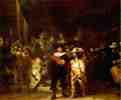tenebroso or
tenebrism - Tenebroso
is an Italian word, literally meaning dark and gloomy. Both tenebroso
and its English equivalent, tenebrism, refer to a style
of painting characterized by
high contrast between
light and shade
— emphasis placed
on chiaroscuro to achieve
dark, dramatic effects.
Frequently the main subjects
of tenebrist pictures are
illuminated by a single source of light, as if a spotlight shone
upon them, leaving other areas in darkness. Such pictures have
been called "night pictures" painted in the "dark
manner." The most reknowned tenebrists have been "Caravaggio",
Michelangelo Merisi (Italian, 1571/73-1610), Georges De La Tour
(French, 1593-1652), and Rembrandt van Rijn (Dutch, 1606-1669).
There is a relationship between tenebrists and other artists who portray night scenes — collectively known as nocturnes.
Examples:

"Caravaggio", Michelangelo Merisi
(Italian, 1571/73-1610), The Crucifixion of St. Andrew, 1607,
oil on canvas,
202.5 x 152.7 cm, Cleveland Museum of Art.

Caravaggio, Medusa, oil on a circular convex leather shield, diameter 55.5 cm, Uffizi Gallery, Florence. See mythology and snake.

Gerrit van Honthorst (Dutch, 1590-1656), The Mocking of Christ, c. 1617, oil on canvas, 57 1/2 x 81 1/2 inches (146.05 x 207.01 cm), Los Angeles County Museum of Art. See Dutch art.

Gerrit van Honthorst,
The Denial of Saint Peter, c. 1620, oil
on canvas, Minneapolis
Institute of Arts.

Georges De La Tour (French, 1593-1652), Magdalen with the Smoking Flame, c. 1640, oil on canvas, 46 x 36 1/8 inches (116.8 x 91.8 cm), Los Angeles County Museum of Art. See Baroque.

Valentin de Boulogne (French, 1594-1632), A Musical Party, c. 1626,
oil on canvas, 44 x 57 3/4 inches (111.76 x 146.69 cm), Los Angeles County Museum of Art.

Rembrandt Harmensz. van Rijn (Dutch, 1606-1669),
The Raising of Lazarus, c. 1630, oil on panel,
37 7/8 x 32 inches (96.2 x 81.3 cm), Los Angeles County Museum
of Art. See Baroque.

Rembrandt Harmensz. van Rijn, Nicolaes Ruts, 1631, oil
on panel, 46 x 34 3/8 inches (116.8
x 87.3 cm), Frick Collection, NY.

Rembrandt Harmensz. van Rijn, The Night Watch, oil on canvas, 1642.

Rembrandt Harmensz. van Rijn, Aristotle with a Bust of Homer, 1653,
oil on canvas,
56 1/2 x 53 3/4 inches (143.5 x 136.5 cm), Metropolitan Museum
of Art, NY. (On the Met's page, you can enlarge any detail.)

Rembrandt Harmensz. van Rijn, Self-Portrait, 1658, oil on canvas, 52 5/8 x 40 7/8 inches (133.7 x 103.8 cm), Frick Collection, NY. See self-portrait.
Also see Baroque, Caravaggisti, crepuscular, luminosity, night blindness (nyctalopia), and nocturne.
https://inform.quest/_art